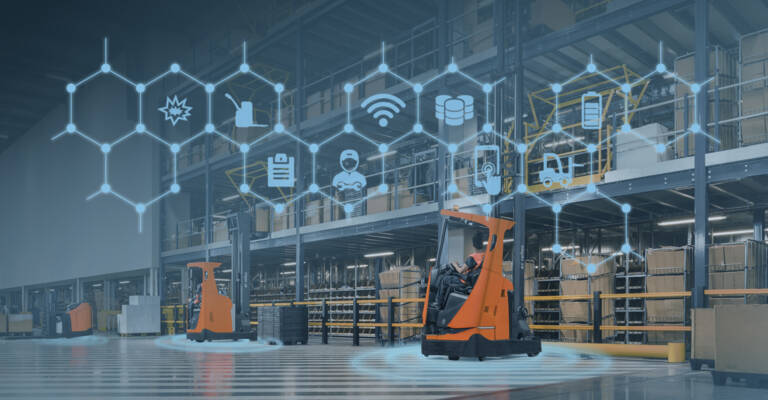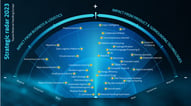Smart Manufacturing and Connectivity at Toyota
Smart manufacturing and Industry 4.0 solutions are now in full swing, permanently transforming the production landscape in the pursuit of ever-increasing value. With this in mind, The Leadership Network sought to gather some key insights into what it takes to identify priorities and action them effectively whilst remaining flexible. We recently had the chance to speak with Sven Kruizenga, Head of Connectivity at Toyota Material Handling Europe, about the changes that Toyota’s processes and strategies have undergone to implement connectivity as a core business strategy.
Connectivity as a central component of Toyota’s strategy
For years now, Toyota has been making committed steps to integrate connectivity and Industry 4.0 technologies into their strategy and products. In 2018, they made the decision to outfit all new trucks with the sensors to communicate and collect data with the goal to aid Toyota and their customers in understanding how to improve safety, reduce costs and optimise the overall efficiency of their operations. This significant move into digitalisation demonstrates the conviction that Toyota has in these cutting-edge solutions and the value prospects they offer. Sven tells us that at Toyota, they go by a saying:
No data equals no measurement. No measurement equals no improvement.
As a leading materials handling manufacturer, Toyota has proven its dominance in the field time and time again. With more than 130,000 trucks connected on a global scale, they were the earliest and most confident adopters of these Industry 4.0 solutions and promise further innovation as time and technologies progress. Toyota makes it clear that a pursuit of data gathering and connectivity is no side-operation to be worked on as a secondary goal, but a core component of their business strategy as they move forward. Sven tells us how outfitting their new “smart trucks” with smart technology enables them to access critical data and make fact-based flexible decisions:
Wear and tear can be closely monitored in order to implement preventative maintenance and allow both Toyota and the customer to save costs long-term. Usage can also be monitored, enabling customers to save money when the trucks aren’t being used. There are countless opportunities like these.
Preventative maintenance is the ultimate goal for Toyota when it comes to connectivity, and equipping their trucks with digital solutions serve as a major step towards that goal. Sven stresses that Toyota wanted to make the digitalisation process as seamless as possible for both the business and its customers, with no need for deep structural changes or alteration to traditional processes:
We make it as easy as possible for any customers that want to go into the smart truck process. There is no need for technical knowledge or infrastructures in place. Companies don’t need to overhaul their existing manufacturing platforms. We do what we can to encourage customers to embrace connectivity.
To begin receiving direct insights and data from their trucks, customers need only to activate an account; Toyota encourages companies to embrace these offerings by showing how simple and painless it is. The simpler things are for everyone involved, the easier it is for Toyota to build value-adding and long-term relationships with its customers.
To further add value to its customers, Toyota uses the same smart trucks within its own operations. This allows them to learn from their own needs and apply their first-hand experience when supporting customers. Toyota strives to always be learning and developing, sharing best practice across as many industries as possible and serving as an inspiration for other companies considering the implementation of Industry 4.0 solutions.

Aligning lean and connectivity on a global scale
Whilst promising better customer support and more advanced products, the data collected ultimately allows Toyota to remove waste throughout its supply chain – the core pillar of lean. Whether it’s measuring downtime, allocating the correct amount of resources, redirecting resources from one task to another, or any number of other potential scenarios, it all contributes towards a leaner and more efficient holistic process. When implementing new programs, it is essential to ensure a common vision for the future of your business. This is particularly important when you have operations all over the world like Toyota. While these distances can create difficulties, the range of demands and requirements across markets can offer helpful insights and reminders. Toyota work to use the same organizational set-up to solve all requirements, no matter the global differences. This blanket approach forces Toyota to remain attentive and flexible at all times, making adjustments where necessary. Another benefit of one set-up overseeing all markets is that individual markets have the chance to learn from each other:
We can use the data gathered to identify successes in individual markets and then learn to duplicate those successes elsewhere. For example, the United States has more advanced sales and advisory teams. How can we adapt that? Another example would be the success that Europe has achieved from its extremely large base of 130,000 connected trucks on the road already. How is Europe using this data to their advantage? Perhaps the US and other continents can learn from this.
Maintaining growth throughout smart implementation
When creating company-wide change, it’s expected that every area of the workforce will need to undergo gradual changes, such as learning how to best utilise new developments and how they can be best transferred into insights and benefits for customers.
For sales personnel, it means a transition to utilising data to be able to make fact-based improvement suggestions for the customers. As the sales force is the primary point of contact between Toyota and its customers, placing data at the heart of their operations and transitioning away from a traditional selling of equipment approach is crucial.
This is a key part of the digitalisation transition process. It’s not a traditional sales force anymore. We can’t just tell customers what is right, our teams go further and become advisors rather than salesmen. We take the data gathered from the customer’s smart trucks and discuss it with them, offering suggestions and solutions for improvement along the way.
No matter how revolutionary your product or solution, if the front-end cannot operate effectively and sell it, then you have no value. This is more important then ever in times when many of us are interacting with products and services remotely, requiring value-added interactions at every step.

This article was written in cooperation with The Leadership Network.


.jpg?width=191&name=TRG80_A002_SEnS+_detection%20(1).jpg)

